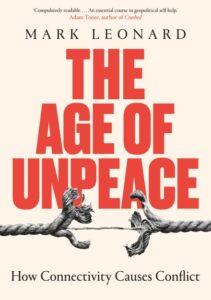 What do China’s mask diplomacy, America’s sanctions on Iran, Russia’s election interference, Belarus’s migration policy, struggles over Huawei, Covid-19 and Climate change have in common? Although seemingly separate events, they are all examples of globalization being weaponized, says the European Council on Foreign Relations.
What do China’s mask diplomacy, America’s sanctions on Iran, Russia’s election interference, Belarus’s migration policy, struggles over Huawei, Covid-19 and Climate change have in common? Although seemingly separate events, they are all examples of globalization being weaponized, says the European Council on Foreign Relations.
Ivan Krastev, chair of the Centre for Liberal Strategies, and Lykke Friis, ECFR co-chair and Director of the Danish Think Tank Europa, discuss The Age of Unpeace: How Connectivity Causes Conflict with author Mark Leonard, director of the European Council on Foreign Relations.
When the COVID-19 crisis began, it was difficult to imagine the severity of the pandemic’s consequences for political, economic, and human rights, notes Ryan Arick, Program Assistant for the International Forum for Democratic Studies. Though governments and leaders needed to make difficult decisions to prevent COVID-19’s spread, several regimes eroded human rights protections and manipulated pandemic response measures to amass personal or state power. Over the last year and a half, the International Forum has closely tracked these developments, including within the information space and the pandemic’s effect on transnational kleptocracy, that represent immense challenges to democracy.
According to Freedom House’s Freedom in the World report, the status of democracy and human rights has worsened in 80 countries since. . [READ MORE]
 Consequently, the International Forum for Democratic Studies today launches a specialized newsletter that examines how authoritarians around the world have manipulated the COVID-19 pandemic to their advantage, writes Christopher Walker, Vice President for Studies and Analysis, National Endowment for Democracy. This curated newsletter will focus on the narratives that authoritarian governments peddle to burnish their image abroad, the growing battles over the distribution of vaccines, crackdowns at home and across borders in the name of public health measures, the pandemic’s intersections with new technologies, and—most importantly—how civil society and the nongovernmental sector more broadly are responding. Each week, we’ll focus on one Big Story where we’ll analyze and unpack some of the most significant trends in this space. If you enjoy this newsletter, forward it to a friend or share it on social media so that others can subscribe.
Consequently, the International Forum for Democratic Studies today launches a specialized newsletter that examines how authoritarians around the world have manipulated the COVID-19 pandemic to their advantage, writes Christopher Walker, Vice President for Studies and Analysis, National Endowment for Democracy. This curated newsletter will focus on the narratives that authoritarian governments peddle to burnish their image abroad, the growing battles over the distribution of vaccines, crackdowns at home and across borders in the name of public health measures, the pandemic’s intersections with new technologies, and—most importantly—how civil society and the nongovernmental sector more broadly are responding. Each week, we’ll focus on one Big Story where we’ll analyze and unpack some of the most significant trends in this space. If you enjoy this newsletter, forward it to a friend or share it on social media so that others can subscribe.







